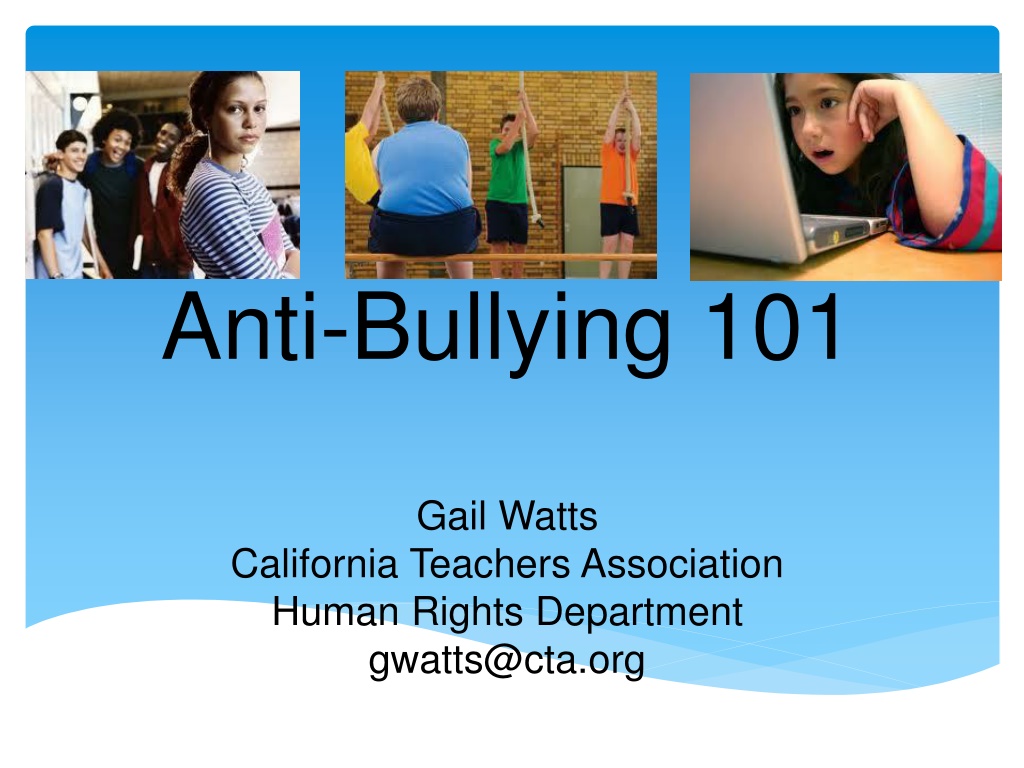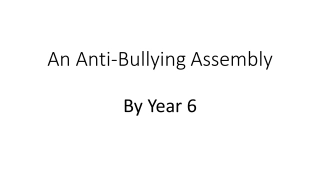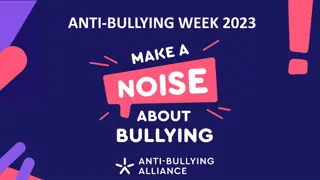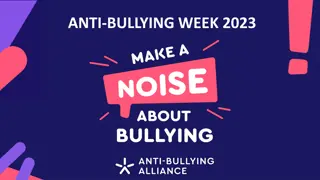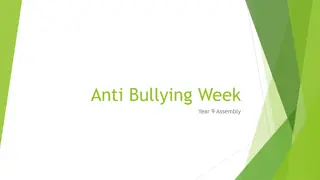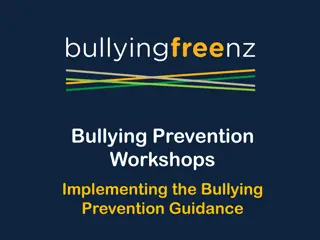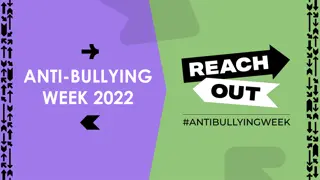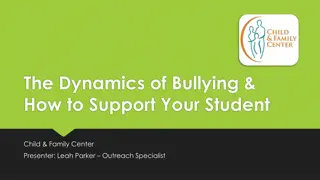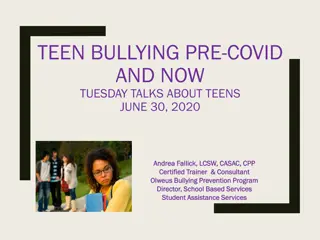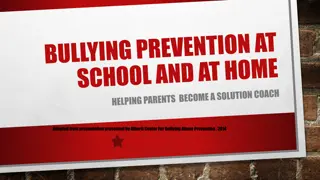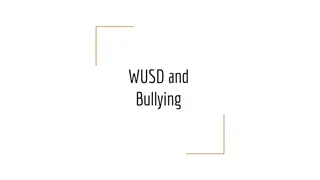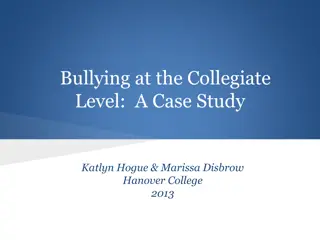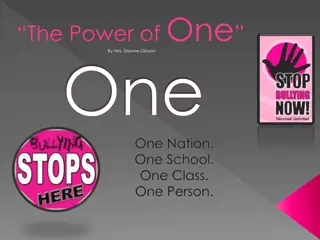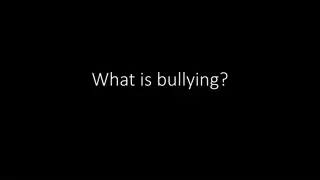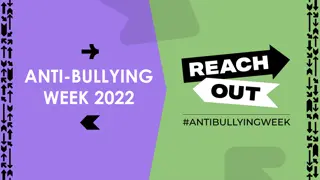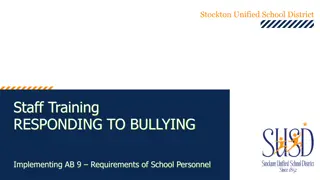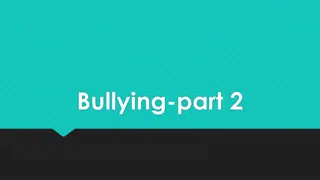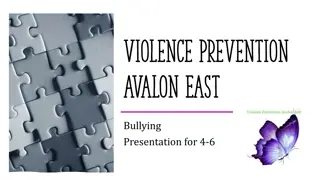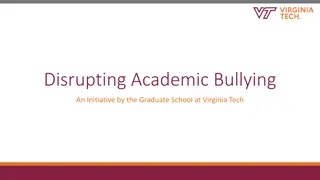Understanding Bullying: Facts, Statistics, and Prevention Efforts
Exploring the impact of bullying in educational settings, this content provides insights into the definition of bullying, its effects on students, and statistics highlighting the prevalence of bullying. Additionally, it addresses crucial questions surrounding bullying in schools, such as the difference between teasing and bullying, disciplinary actions for bully behavior, and teacher interventions. The information sheds light on the severity of the issue and the importance of proactive measures to combat bullying.
Download Presentation

Please find below an Image/Link to download the presentation.
The content on the website is provided AS IS for your information and personal use only. It may not be sold, licensed, or shared on other websites without obtaining consent from the author. Download presentation by click this link. If you encounter any issues during the download, it is possible that the publisher has removed the file from their server.
E N D
Presentation Transcript
Anti-Bullying 101 Gail Watts California Teachers Association Human Rights Department gwatts@cta.org
What Is Bullying? When was a definition of bullying added to the California Education Code? Can a student in K-12 system be suspended for bullying another student? Can a student be suspended for a bullying act that doesn t take place at school? If a student creates a derogatory facebook page about a teacher, is that free speech or bullying?
What Is Bullying? +Intent to hurt + Power to hurt + Hurtful action + Repetition (most of the time) + Secrecy (most of the time) = B U L L Y I N G
Is There A Difference Between Bullying and Teasing? Billy bully ready for a fight Animated Clipart Matthew Teasing Animated Clipart VS
Bullying Facts And Statistics Almost 30% of youth in the United States are estimated to be involved in bullying as either a victim or bully 60% of those characterized as bullies in grades 6-9 had at least one adult criminal conviction by age 24 and 3 arrests by age 30 Source: National Violence Prevention Center
Bullying Facts And Statistics More than 43% of middle school and high school students avoid using school bathrooms for fear of being harassed or assaulted (Mothering) One in fifteen students said they avoided certain places at school because they feared of being attacked (Harvard School of Public Health)
Bullying Facts And Statistics Only 25% of students reported that teachers intervene in bullying situations, while 71% of teachers believe they always intervene (Source: www.bullybeware.com) When asked, students uniformly expressed the desire that teachers intervene rather than ignore teasing and bullying (Source: Maine Project Against Bullying)
Bullying Facts And Statistics College Students: 15% report being bullied. 22% report being cyberbullied 38% of college students knew someone who had been cyberbullied 9% report they had cyberbullied someone else 15% had seen a professor bully a student (US News & World Report, Nov 3, 2011) Workplace: 37% of workers (54 million people) reported they had been bullied at work. (Psychology Today, Feb 2, 2010, Cutting-Edge Leadership)
I was at school every day and had no idea of the horror that was brewing. - Columbine Principal
Types of Bullying Verbal Physical Social / Relational Cyber Reactive
Verbal Bullying Using language to gain power over peers. Most common form of bullying. Difficult to identify. May leave lasting psychological impact on victims. Examples: Name-calling Insults Jokes Threats Source: http://www.stopbullying.gov About.com, http://tweenparenting.about.com/od/physicalemotionalgrowth/tp/Types-of-Bullying.htm Norfolk County Council, http://www.schools.norfolk.gov.uk/index.cfm?s=1&m=1096&p=1263,page&id=548 Respect, http://www.respect2all.org/students/bullying-definitions
Physical Bullying Use overt bodily acts to gain power over peers. Generally more obvious. Physical bullying is rarely the first form of bullying that a target will experience. Source: http://www.stopbullying.gov About.com, http://tweenparenting.about.com/od/physicalemotionalgrowth/tp/Types-of-Bullying.htm Norfolk County Council, http://www.schools.norfolk.gov.uk/index.cfm?s=1&m=1096&p=1263,page&id=548 Respect, http://www.respect2all.org/students/bullying-definitions Examples: Hitting Kicking Groping Spitting Shoving Damaging belongings Stealing
Social / Relational Bullying Intent to harm reputation or social standing. Often happens among friends. 2 main methods: make someone feel unwelcome or gain someone s trust and then break it. Source: http://www.stopbullying.gov About.com, http://tweenparenting.about.com/od/physicalemotionalgrowth/tp/Types-of-Bullying.htm Norfolk County Council, http://www.schools.norfolk.gov.uk/index.cfm?s=1&m=1096&p=1263,page&id=548 Respect, http://www.respect2all.org/students/bullying-definitions Examples: Telling secrets told in confidence Spreading rumors/gossip Exclusion Breaking up friendships Encouraging others to ignore or chastise Ranking or rating others
Cyber Bullying Harassment that occurs using technology. Happens 24/7/365 Students more tech savvy. Unsupervised. Can be shared with wide audience. Anonymous but traceable. Exacerbates effects on victim when used with other forms of bullying. http://www.stopbullying.gov About.com, http://tweenparenting.about.com/od/physicalemotionalgrowth/tp/Types-of-Bullying.htm Norfolk County Council, http://www.schools.norfolk.gov.uk/index.cfm?s=1&m=1096&p=1263,page&id=548 Respect, http://www.respect2all.org/students/bullying-definitions Examples: Social media (facebook, twitter, etc) Text, instant message, email, chat room posts Fake websites or social media profiles Videos, photos
Reactive Bullying Causes conflict AND is attacked by peers. Reactive bullies may target those that have also acted as a bully. Examples: Taunting a peer until the peer reacts. Then claims to be a victim. Source: http://www.stopbullying.gov About.com, http://tweenparenting.about.com/od/physicalemotionalgrowth/tp/Types-of-Bullying.htm
Bullying: Whos Affected? Bully Victim or Target Bystander / witness passively watch Assistant take part in ridicule or intimidation Reinforcer encourage by showing signs of approval Defender intervene, distract, discourage Bullying: A Module for Teachers, Sandra Graham, http://www.apa.org/education/k12/bullying.aspx
Bullying: Whos Affected? The VICTIM or TARGET tends to: Have low self-esteem Be less popular Have few or no friends Social minorities Be passive Socially withdrawn Depressed, anxious and lonely May blame themselves for predicament Bullying: A Module for Teachers, Sandra Graham, http://www.apa.org/education/k12/bullying.aspx http://www.stopbullying.gov/topics/risk_factors/index.html
Bullying: Whos Affected? The BULLY tends to: Be well connected Have social power Have lots of friends Have high self-esteem May be overly concerned about their popularity. May tend to dominate / be in charge of others. May have inflated self-views
True or False? True or False? Based on reported incidences, Based on reported incidences, males bully more than females. males bully more than females. True True
True or False? True or False? Because of its prevalence, many Because of its prevalence, many accept bullying as part of growing accept bullying as part of growing up. up. True True
True or False? True or False? The United States is the leading The United States is the leading country on programs to address country on programs to address bullying. bullying. False
True or False? True or False? Bullies are loners, low academic Bullies are loners, low academic achievers, insecure and usually achievers, insecure and usually have few friends. have few friends. False
True or False? True or False? Those who bullied or were bullied Those who bullied or were bullied as students are likely to become as students are likely to become bullies as adults. bullies as adults. True True
True or False? True or False? Fighting back or standing up to a Fighting back or standing up to a bully will stop the behavior. bully will stop the behavior. False
Anti-bullying Super Heroes Immediate Intervention Strategies: 1. Separate those who are engaged as bullies and victims. Talk to them separately. 2. Create a safe place for those targeted. 3. Delve into behavior of why students are bullying. 4. Hold bystanders accountable.
Intervention: Turning Around Bullying Behavior 1. Assess the extent of the bullying problem. 2. Ensure that the class understands the definition of bullying 3. Confront students engaged in bullying in a firm and fair manner. 4. Provide appropriate and consistent consequences for bullying. Preventing Classroom Bullying: What Teachers Can Do, Jim Wright, www.interventioncentral.org
Resources California Department of Education (www.cde.ca.gov) Learning Support/Safe Schools Sample Bullying Prevention Policy Sample Policy for Conflict Resolution How Does A Caring Adult Talk To A Bully?
Resources Classroom Activities Chalk Talk www.schoolsafety.us Bully Busters www.stopbullyingnow.net Take Action Now www.education.com/bullying NEA www.nea.org/ToolsandIdeas Teaching Tolerance www.tolerance.org
